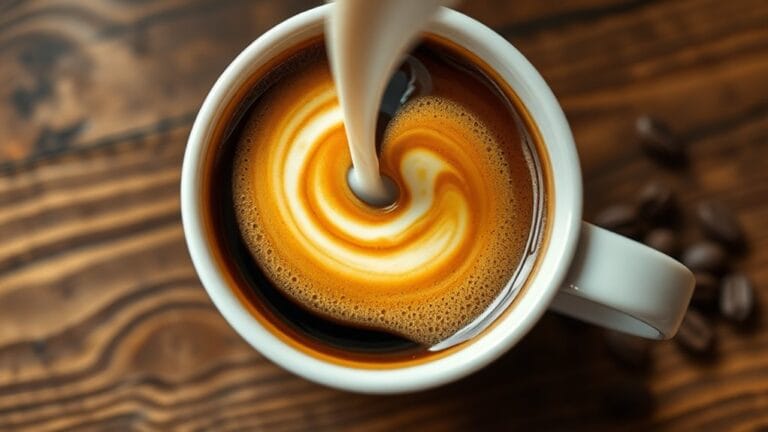Espresso mixed with warm milk creates creamy coffee drinks like lattes, cortados, or flat whites, blending bold coffee flavor with silky-smooth texture. The espresso—strong, dark-roasted coffee brewed under pressure—is paired with steamed or frothed milk, often whole, oat, or almond, depending on taste. Drink styles vary: lattes use more milk for mildness, while cortados balance equal parts espresso and milk for a stronger kick. Add-ins like honey, caramel, or cinnamon add sweetness, while proper heating (140–145°F milk) guarantees rich, bitter-sweet harmony. Uncover more tasty twists ahead!
Key Ingredients for Espresso and Warm Milk Blends
Four key ingredients come together to create the perfect espresso and warm milk blend.
Initially, espresso—bold, rich, and made from dark-roasted beans finely ground to extract 25-30ml of intense flavor.
Secondly, high-quality water, heated to 90-96°C, guarantees flawless brewing without weird aftertastes.
Thirdly, warm milk steps in, like whole or oat milk, steamed to 60-70°C for silky smoothness, blending bitterness into sweetness. The Spanish Cortado illustrates this harmony, combining equal parts espresso and steamed milk for a smooth yet bold profile. This drink emphasizes maintaining strong coffee flavor balanced by milk dilution and is served in a traditional Gibraltar glass that enhances its presentation. Ultimately, flavor enhancers: a dash of honey, a drizzle of caramel, or a sprinkle of cocoa, adding personality without overpowering the coffee’s soul.
Together, these elements turn coffee into comfort—creamy, balanced, and endlessly adaptable.
Crafted elements harmonize, transforming coffee into velvety warmth—balanced, comforting, infinitely customizable.
Whether poured over ice or sipped steaming hot, this combo lets drinkers craft moments of pure, caffeinated freedom, one perfect sip at a time.
Preparation Techniques for Optimal Flavor and Texture
Creating the perfect blend of espresso and warm milk isn’t just about what’s in the cup—it’s how you put it there. Milk should hit 140–145°F—hot enough to improve flavor, but never boiling, to keep it silky. Use a steam wand angled to create a whirlpool in the pitcher, forcing tiny bubbles for velvety microfoam. For those without a steam wand, a French Press offers an effective alternative to froth milk by vigorously pumping the plunger until foam forms. This method retains robust flavor extraction, allowing for a delightful combination of coffee and milk. Let the milk rest 15 moments so foam and liquid merge smoothly, like a coffee-flavored hug. Additionally, the balance of milk and espresso enhances the overall experience, much like the blend of spices in a chai tea latte. Pour into espresso at a slight tilt, starting high for mixing and lowering the pitcher to layer foam art.
Time is key: pull shots fresh (25–30 moments) and pour milk fast to fuse flavors. Clean tools, cold milk, and precise scales? Non-negotiables.
Think of it as science, but tastier—no lab coat required.
Cultural Variations in Espresso and Milk Beverages

Espresso with milk isn’t the same everywhere—each culture adds its own twist, like a coffee playground where rules change based on where you stand.
In Italy, *cortado* balances espresso and steamed milk fairly, letting coffee shine without foam, while Australians wrap their *flat whites* in velvety microfoam for creamy, coffee-forward sips. The prevalence of the 1:1 ratio in a cortado allows for a nuanced flavor that highlights both coffee and milk.
Spain’s *café con leche* pairs espresso with warm milk for breakfast, and the U.S. drowns espresso in steamed milk with lattes, prioritizing softness over intensity. Here, the rich texture is enhanced by barista oat milk, which brings natural sweetness and creaminess.
Latin America swaps froth for scalded milk’s sweetness, and France simmers espresso in hot milk for a cozy *café au lait*.
From Italy’s bold simplicity to Miami’s condensed-milk *cortaditos*, these drinks are a cosmic dance of local tastes—proof that coffee adapts, twists, and delights wherever it goes.
Frequently Asked Questions
How Does Espresso With Warm Milk Affect Caffeine Content?
Adding warm milk dilutes espresso’s caffeine concentration per ounce but does not reduce total caffeine content, which depends solely on espresso shots used. Effects depend on ingested caffeine dose, unaffected by milk dilution.
Can Lactose-Free Milk Be Used Instead of Regular Milk?
A creamy stream of lactose-free milk swirls into espresso, mirroring regular milk’s texture. Substitutions retain richness while accommodating dietary preferences, requiring no adjustments in preparation methods—ideal for those prioritizing flexibility without compromising coffee’s bold essence.
What Is the Origin of Espresso Mixed With Warm Milk?
Espresso mixed with warm milk originated in 18th-century Viennese coffeehouses, specifically the *Kapuziner*—coffee with cream—later evolving in Italy through espresso machine advancements. Trieste’s Habsburg ties fused Austrian traditions with Italian innovation, creating modern iterations like cappuccino.
How Does Temperature Impact Espresso’s Flavor When Mixed?
Temperature gently coaxes espresso’s hidden harmonies, balancing muted sweetness and softened bitterness. Ideal warmth amplifies aromatic whispers—caramel, nutty notes emerge—while cooling reveals subtler tones, its astringency softened by milk’s liquid hug.
Is Espresso With Warm Milk Suitable for Lactose-Intolerant Individuals?
Espresso with warm milk typically contains lactose, which may cause discomfort for lactose-intolerant individuals. Plant-based alternatives like almond, soy, or lactose-free milk substitute dairy, enabling those with sensitivities to consume similar beverages without adverse effects.
References
- https://www.acouplecooks.com/how-to-make-cappuccino/
- https://outin.com/blogs/outin-coffee-recipes/cappuccino-making-guide
- https://en.wikipedia.org/wiki/Cappuccino
- https://www.thespruceeats.com/how-to-make-cappuccinos-766116
- https://fixxcoffee.com/blogs/glossary/cappuccino
- https://phillyfairtrade.com/blogs/learn/the-best-espresso-and-milk-drinks-with-recipes-you-can-make-at-home
- https://www.allrecipes.com/recipe/96629/cafe-latte/
- https://recipesfromfrenchcreek.com/nescafe-latte-recipe/
- https://www.youtube.com/watch?v=5ckd1aUa2Lo
- https://www.smells-like-home.com/2024/01/19-different-espresso-drinks-to-make-at-home-a-guide/





